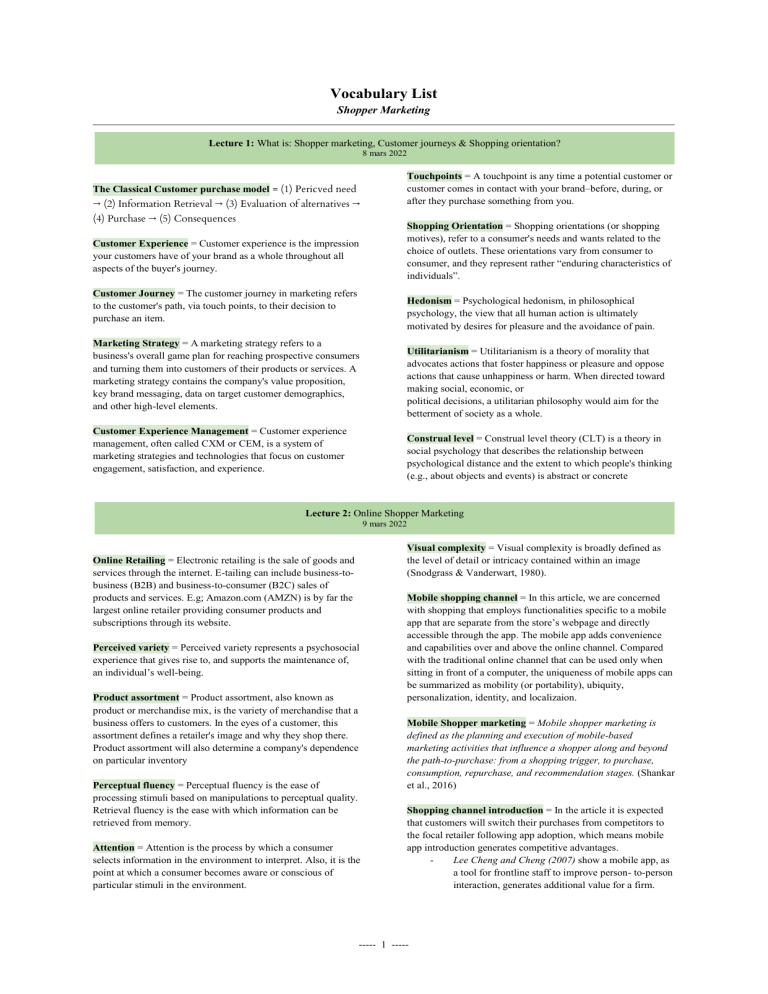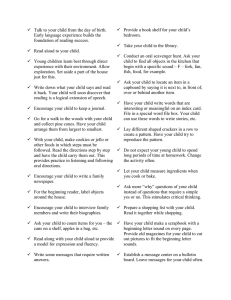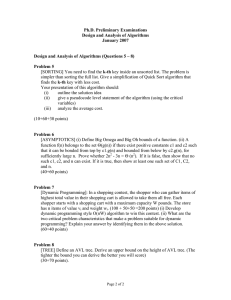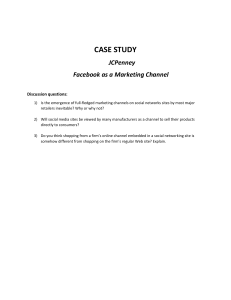
Vocabulary List Shopper Marketing Lecture 1: What is: Shopper marketing, Customer journeys & Shopping orientation? 8 mars 2022 Touchpoints = A touchpoint is any time a potential customer or customer comes in contact with your brand–before, during, or after they purchase something from you. The Classical Customer purchase model = (1) Pericved need → (2) Information Retrieval → (3) Evaluation of alternatives → (4) Purchase → (5) Consequences Shopping Orientation = Shopping orientations (or shopping motives), refer to a consumer's needs and wants related to the choice of outlets. These orientations vary from consumer to consumer, and they represent rather “enduring characteristics of individuals”. Customer Experience = Customer experience is the impression your customers have of your brand as a whole throughout all aspects of the buyer's journey. Customer Journey = The customer journey in marketing refers to the customer's path, via touch points, to their decision to purchase an item. Hedonism = Psychological hedonism, in philosophical psychology, the view that all human action is ultimately motivated by desires for pleasure and the avoidance of pain. Marketing Strategy = A marketing strategy refers to a business's overall game plan for reaching prospective consumers and turning them into customers of their products or services. A marketing strategy contains the company's value proposition, key brand messaging, data on target customer demographics, and other high-level elements. Utilitarianism = Utilitarianism is a theory of morality that advocates actions that foster happiness or pleasure and oppose actions that cause unhappiness or harm. When directed toward making social, economic, or political decisions, a utilitarian philosophy would aim for the betterment of society as a whole. Customer Experience Management = Customer experience management, often called CXM or CEM, is a system of marketing strategies and technologies that focus on customer engagement, satisfaction, and experience. Construal level = Construal level theory (CLT) is a theory in social psychology that describes the relationship between psychological distance and the extent to which people's thinking (e.g., about objects and events) is abstract or concrete Lecture 2: Online Shopper Marketing 9 mars 2022 Visual complexity = Visual complexity is broadly defined as the level of detail or intricacy contained within an image (Snodgrass & Vanderwart, 1980). Online Retailing = Electronic retailing is the sale of goods and services through the internet. E-tailing can include business-tobusiness (B2B) and business-to-consumer (B2C) sales of products and services. E.g; Amazon.com (AMZN) is by far the largest online retailer providing consumer products and subscriptions through its website. Perceived variety = Perceived variety represents a psychosocial experience that gives rise to, and supports the maintenance of, an individual’s well-being. Product assortment = Product assortment, also known as product or merchandise mix, is the variety of merchandise that a business offers to customers. In the eyes of a customer, this assortment defines a retailer's image and why they shop there. Product assortment will also determine a company's dependence on particular inventory Mobile shopping channel = In this article, we are concerned with shopping that employs functionalities specific to a mobile app that are separate from the store’s webpage and directly accessible through the app. The mobile app adds convenience and capabilities over and above the online channel. Compared with the traditional online channel that can be used only when sitting in front of a computer, the uniqueness of mobile apps can be summarized as mobility (or portability), ubiquity, personalization, identity, and localizaion. Mobile Shopper marketing = Mobile shopper marketing is defined as the planning and execution of mobile-based marketing activities that influence a shopper along and beyond the path-to-purchase: from a shopping trigger, to purchase, consumption, repurchase, and recommendation stages. (Shankar et al., 2016) Perceptual fluency = Perceptual fluency is the ease of processing stimuli based on manipulations to perceptual quality. Retrieval fluency is the ease with which information can be retrieved from memory. Attention = Attention is the process by which a consumer selects information in the environment to interpret. Also, it is the point at which a consumer becomes aware or conscious of particular stimuli in the environment. Shopping channel introduction = In the article it is expected that customers will switch their purchases from competitors to the focal retailer following app adoption, which means mobile app introduction generates competitive advantages. Lee Cheng and Cheng (2007) show a mobile app, as a tool for frontline staff to improve person- to-person interaction, generates additional value for a firm. ----- 1 ----- - Nysveen et al. (2005) verify mobile push media as a tool for improving brand relationships between purchases or interactions. willingness to click on links, the prevalence of comparison shopping, among others. Environmental psychology = Environmental psychology examines the interrelationship between environments and human behavior. The field defines the term environment very broadly including all that is natural on the planet as well as social settings, built environments, learning environments, and informational environments. Environmental Psychology emphasizes how humans change the environment and how the environment changes humans' experiences and behaviors. The field defines the term environment broadly, encompassing natural environments, social settings, built environments, learning environments, and informational environments. E.g; Conducting research on messages that motivate people to change their behavior. Spreading the word about environmental solutions. Uncovering why people may not adopt positive behaviors. Encouraging people to rethink their positions in the natural world. Multichannel marketing = Multichannel marketing refers to the practice by which companies interact with customers via multiple channels, both direct and indirect, to sell them goods and services. Companies use direct channels, ones in which the company proactively reaches the customer -- such as physical stores, catalogs, and direct mail -- or indirect ones in which they push content via websites or social media, also known as inbound marketing. Retailing = Note grocery retailing differs significantly from many other shopping contexts. Unlike B2B, entertainment, and apparel, groceries are a necessity to consumers, and household total spending on groceries does not change drastically from month to month. Therefore, determining whether the addition of a mobile app for a necessity market, such as groceries, simply shifts consumers’ grocery shopping from existing channels to the new channel, resulting in a zero net gain for the focal chain, or increases consumers’ total grocery spending with the focal chain by strengthening its competitive standing in the local grocery market is important. Concreteness = The thing about concreteness is that it makes people think that you're very much capable of doing anything that leads to success. From your delivery to your content, we will make sure that you will have what it takes to build an advertisement that will carry your purest intentions to the public. E-tail = E-tailing is short for electronic retailing and refers to the specific activities related to selling retail products and services via the internet. The keywords in this definition are “retail products and services.” Digital commerce = Digital commerce is the process of buying things online without human intervention. Web aesthetics = Aesthetics refers to the visual appearance of the website, web application, or mobile app developed using front-end technologies. Satisfaction = Satisfaction is the consumer's fulfillment response. It is a judgment that a product or service feature, or the product or service itself, provided (or is providing) a pleasurable level of consumption-related fulfillment, including levels of under-or over-fulfillment. Online service quality = Service quality is a measure of how an organization delivers its services compared to the expectations of its customers. Customers purchase services as a response to specific needs. Results show that e-service quality is a fourdimensional construct: website design, customer service, security/privacy, and fulfillment. The hierarchical model also has a higher predictive ability of consumer behavior than other existing measurements. Eleven dimensions of online service quality: access, ease of navigation, efficiency, flexibility, reliability, personalization, security/privacy, responsiveness, assurance/trust, site aesthetics, and price knowledge. Online consumer behavior = The phrase “online consumer behavior” describes the process of online shopping from a consumer's perspective. It is often described as the study of trends, including the influence of online advertising, consumer Information processing = Information processing, the acquisition, recording, organization, retrieval, display, and dissemination of information. In recent years, the term has often been applied to computer-based operations specifically. Market information processing, then, is a function of what the organization has learned in terms of both facts about its relevant markets and its particular way of acquiring, distributing, interpreting, and storing information. Need for cognition = Need for Cognition (NC) refers to “the tendency for an individual to engage in and enjoy thinking” (Cacioppo and Petty, 1982, p. 116) Picture size = For the visual stimuli, large and small picture sizes were operationally defined as 400 × 480 pixels and 150 × 180 pixels, respectively. Product presentation = What is a presentation of products? A presentation of products introduces customers to a new product that a company wants to offer. Product presentations often involve prepared statements given by a public speaker, and they might use visual aids like slideshows, photographs or videos. Lecture 3: Assortment Strategies 14 mars 2022 Shelf space = The total amount of space available in a store to display goods for sale, or the amount of space for particular goods: shelf space for sth A store that orders too many copies of one book has less money and shelf space for others. Shelf space elasticity = The relationship between shelf space and sales is usually measured in terms of the shelf space elasticity, that is, the ratio of changes in sales to changes in space. ----- 2 ----- Meta-analysis = A meta-analysis is a statistical analysis that combines the results of multiple scientific studies. Meta-analyses can be performed when there are multiple scientific studies addressing the same question, with each individual study reporting measurements that are expected to have some degree of error. Lecture 4: In-store Atmospherics 16 mars 2022 Arousal = Arousal generally refers to the experience of increased physiological (inside-the-body) activity. This can include an increased (faster) heart rate, perspiration, and rapid breathing. In some cases, the term arousal is used to specifically refer to sexual feelings (and the resulting bodily changes). From a psychophysiological point of view, arousal is a fundamental feature of behavior. As reported in different empirical studies based on insights from theories of consumer behavior, store atmosphere should evoke phasic arousal reactions to attract consumers. Pleasantness = The quality of being enjoyable, attractive, friendly, or easy to like… Lecture 5: Sustainable Shopper Marketing 22 mars 2022 Corporate social responsibility = Corporate social responsibility, also known as CSR, is the concept that a business has a responsibility to do good. CSR means that a company should self-regulate its actions and be socially accountable to its customers, stakeholders, and the world at large. Ecological behavior = Ecological behavior means “actions which contribute towards environmental preservation and/or conservation” Environmentally friendly behavior = Pro-environmental or green behavior is behavior that minimizes harm to the environment as much as possible or even benefits it (Steg & Vlek, 2009). Examples include minimizing energy use and reducing waste. More simply, it has been described as 'doing good and avoiding bad' (Cushman-Roisin, 2012). Sustainable consumer behavior = Three important sets of attitudes that influence consumers' willingness to engage with sustainability issues are perceived personal relevance, social responsibility, and trust. Sustainable Behavior = Individuals and society participate in achieving the goals of sustainability by means of engagement in sustainable behavior (SB). SB is the set of deliberate and effective actions that result in the conservation of natural and social resources; it encompasses pro-ecological, frugal, altruistic, and equitable behaviors.13 Sustainable Customer = Sustainable customer service means identifying the CORE elements that customers require AND that are reasonable in terms of the company's business processes. For example, whatever a company does to meet the needs of customers must not result in damage to the company. Nudging = A popular term for describing efforts to foster sustainable behaviors is “nudging”. Nudging can be described as initiatives to foster desirable behaviors (e.g., environmentally or socially sustainable choices) through different interventions (e.g., the design of the product, service, assortment, or store environment) that steer consumers towards such behaviors without forcing them. SHIFT Framework = The framework is represented by the acronym SHIFT, and it proposes that consumers are more inclined to engage in pro-environmental behaviors when the message or context leverages the following psychological factors: Social influence, Habit formation, Individual self, Feelings and cognition, and Tangibility. ----- 3 -----




